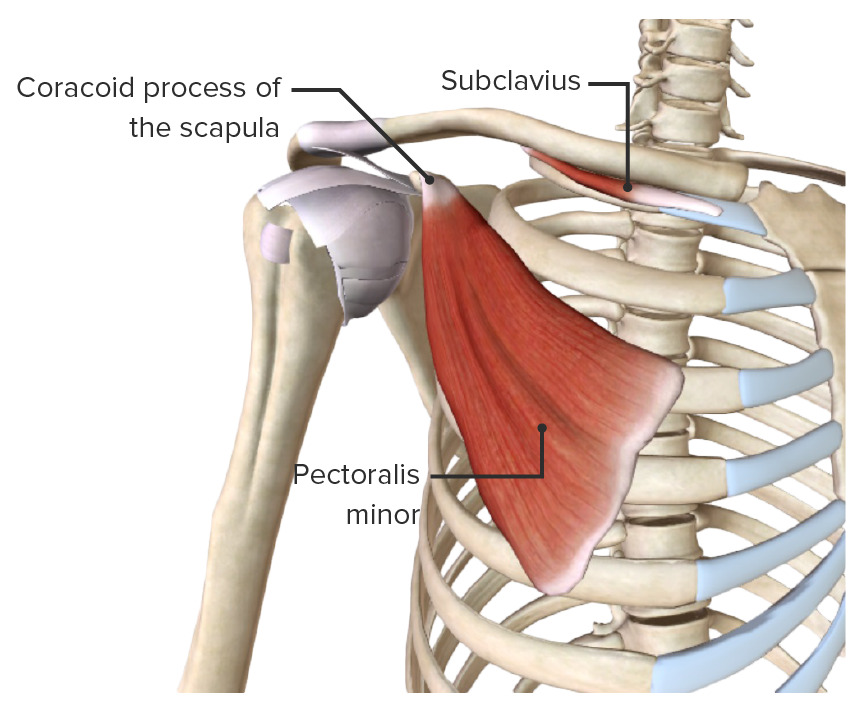Playlist
Show Playlist
Hide Playlist
Scapulohumeral Muscles
-
Slide Scapulohumeral Muscles.pdf
-
Reference List Anatomy.pdf
-
Download Lecture Overview
00:01 Now, let's have a look at the scapulohumeral muscles. 00:04 Muscles that pass from the scapula to the humerus as the name suggests. 00:09 So, here, we're going to just have a look at the scapula. We can see the medial border. We can also see the spine. 00:15 And we can see the direction of some of these muscles passing from the scapula, all the way across to the humerus. 00:21 And here, we can see the humerus has been highlighted. 00:24 One of the most superficial and prominent muscles really helping to form the shape and the contours of the shoulder is deltoid. 00:31 We can see deltoid there. We also have supraspinatus which is positioned in the supraspinous fossa, superior to the spine of the scapula. 00:40 Here, we have infraspinatus muscle, teres major, and we can also see teres minor. 00:46 Let's go through some of these muscles, and importantly, subscapularis. 00:50 This muscle is only seen looking anterior as it's on the anterior surface of the scapula. 00:56 And it's hidden if you're looking at the posterior view. 00:59 These are important scapulohumeral muscles, so, let's talk about them. 01:03 First of all, we have deltoid. Deltoid has three parts, the clavicular, acromial and spinal parts. 01:11 And the names of the deltoid very much come from their origin, where they leave the bones. 01:16 So, here, we can see we have the origins of the deltoid coming from the lateral third of the clavicle, coming from the acromion and coming from the spine of the scapula. 01:27 And they're all going to converge down onto the lateral aspect of the humerus and the deltoid tuberosity. 01:33 The nerve that supplies this region is the axillary nerve and this has roots coming from both C5 and C6. 01:40 The axillary nerve is an important nerve and we'll see it when we talk about the brachial plexus. 01:46 The function of the deltoid is very much to do with which part of it contracts. 01:51 So, if the clavicular part would contract, you could imagine due to shortening of the fibers and the positioning of the fibers, you're going to have flexion of the shoulder joint. 02:00 You'll also have some medial rotation. 02:03 So, the arm goes forward and can turn around with that clavicular part contracting, turning around to face the medial aspect. 02:11 If you were to have the acromial part contracted, then, what we end up with is abduction of the shoulder. 02:17 So, here, we can see the shoulder is being abducted, is going to move away from the midline of the body when the acromial part contracts. 02:25 Here, we have the spinal part indicated coming from the spine of the scapula, again, down to the deltoid tuberosity. 02:32 And here, we can see with the spinal part contracting, the arm is actually going to extend backwards and it's going to lead to some lateral rotation of the shoulder joint as well. 02:42 So, a large range of movement there from one muscle, deltoid with three different parts. 02:48 Here, we have supraspinatus sitting in the supraspinous fossa. 02:51 We could see that's its origin and it's going to pass all the way over to the superior facet of the greater tubercle of the humerus. 03:00 So, remember, on the humerus, we have the greater and lesser tubercles. 03:04 This is running to a specific part on that greater tubercle. 03:08 It's supplied by the suprascapular nerve that remember, pass through the suprascapular notch. 03:15 Here, we have the supraspinous muscle. This muscle helps to initiate abduction. 03:21 So, previously, we spoke about deltoid helping with abduction. This muscle actually helps to initiate it. 03:28 The deltoid muscle, because of its position, can't actually initiate abduction. 03:33 So, these two muscles need to work in tandem. Supraspinatus initiates abduction. 03:38 And then, the full abduction movement is performed by deltoid. Now, let's have a look at infraspinatus. 03:45 Infraspinatus sits in the infraspinatus fossa, inferior to the spine of the scapula. 03:51 Here, we can see the infraspinatus fossa and the muscle passing from it towards the middle facet of the greater tubercle. 03:58 So, again, we saw the superior facet previously. 04:02 Now, we're looking at the middle facet, specific part of the greater tubercle. 04:07 This muscle is also supplied by the suprascapular nerve. 04:11 This muscle is responsible for laterally rotating the shoulder joint. 04:14 But importantly, it also helps to hold the head of the humerus within the glenoid cavity. 04:21 We have two teres muscles which are named after the kind of cylindrical shape of them which is teres. 04:27 And teres minor is the first one. We also have teres major. 04:31 Here, we have teres minor which is coming from the lateral border of the scapula and this is going to the inferior facet of the greater tubercle. 04:40 So, we've spoken about various facets on the greater tubercle. 04:43 This is the inferior one and the teres minor muscle passes through it from the lateral border of the scapula. 04:50 It's supplied by the axillary nerve which was also supplying deltoid muscle. 04:56 This muscle is responsible for helping to laterally rotate the shoulder joint. 05:00 And again, like infraspinatus, it also helps to hold the head of the humerus in the glenoid cavity. 05:07 Let's speak about teres major, a bigger muscle of the two teres, teres minor, teres major. 05:13 As the name implies, major is larger. 05:16 It comes from a similar position but a bit further down, still on the lateral border of the scapula. 05:22 But this time, it passes all the way over onto the medial lip of the intertubercular groove. 05:27 And hopefully, you can appreciate how this muscle is passing through that space between the humerus and the lateral border of the scapula to appear on the anterior aspect where we can see attaching to the medial lip of the intertubercular groove. 05:42 This muscle when it contracts, is going to be supplied by the lower subscapular nerve we can see here. 05:48 And its movement is gonna be associated with adducting the shoulder joint. 05:52 So, previously, we've seen muscles associated with abducting the shoulder joint, talking about supraspinatus and parts of deltoid. 06:00 This muscle is going to adduct, bring the shoulder towards the midline. 06:04 It's also responsible for the medial rotation of the shoulder joint. 06:08 Hopefully, you could imagine that as the muscle is passing forwards towards the medial lip, contraction of it is going to turn that humerus towards the midline. 06:20 Let's now have a look at subscapularis which can only be seen anteriorly because it's on the anterior surface of the scapula between the scapula and the posterior aspect of the thoracic wall. 06:32 So, here, we can see subscapularis muscle. 06:35 It's coming from the subscapular fossa on the anterior surface of the scapula and it's extending laterally away to the lesser tubercle of the humerus. 06:44 So, here, we could see it passing to the lesser tubercle of the humerus. 06:47 We spoke about other muscles in this region of a scapulohumeral muscles sitting on the greater tubercle. 06:54 This is passing through the lesser tubercle. This muscle is going to be supplied by branches coming off the brachial plexus, specifically, the upper subscapular nerve. 07:05 And we'll see this even when we talk about the brachial plexus later on. 07:09 You may also have some fibers coming from the lower scapular nerve as well and these will help to supply this muscle. 07:16 The functional subscapularis is very much around medial rotation of the shoulder joint and helping to adduct the shoulder joint as well just like we saw with the previous muscle we were talking about, teres major. What's important about a lot of these muscles is we've seen that, yes, they're associated with moving the humerus around the glenoid cavity. 07:38 But a lot of them are associated with holding the head of the humerus against the glenoid cavity. 07:43 And this is important. Unlike the hip joint where you have the head of the femur articulating with the acetabulum of the pelvis, here, we have a much shallower glenoid fossa but still, a ball and socket joint. 07:56 Therefore, to help the stability of that joint but also, to allow the wide range of movement, these muscles help to hold that bony head of the humerus against the glenoid fossa. 08:10 And these muscles are collectively known as the rotator cuff muscles. 08:14 We talk about these in a bit later on in a bit more detail. 08:16 But it's important to reference them here as well. 08:19 So, anteriorly, we can see subscapularis muscle. 08:23 This is one of those rotator cuff muscles but we can only see it here on the anterior view. 08:29 The subscapularis muscle is one of the muscles that actually holds the head of the humerus in position. 08:36 It also is supraspinatus, infraspinatus, and teres minor. 08:41 Those four muscles are known as your rotator cuff muscles. 08:45 And together, they hold the head of the humerus against the glenoid fossa.
About the Lecture
The lecture Scapulohumeral Muscles by James Pickering, PhD is from the course Muscles of the Shoulder.
Included Quiz Questions
Which statements describe the muscles of the back? Select all that apply.
- The rhomboid minor is anatomically located superior to the rhomboid major.
- The trapezius only attaches to the scapula and the vertebral column.
- The latissimus dorsi attaches to the intertubercular (bicipital) groove of the humerus.
- The levator scapulae attaches to the medial border of the scapula at the superior angle.
- The rhomboid major and minor attach to the medial border of the scapula.
Which muscles are part of the rotator cuff group of muscles? Select all that apply.
- Teres minor
- Latissimus dorsi
- Supraspinatus
- Infraspinatus
- Subscapularis
Which nerve contains nerve roots from C5 and C6 only?
- Axillary
- Long thoracic
- Radial nerve
- Fibular nerve
- Median nerve
Which statements describe the deltoid? Select all that apply.
- Its principle movement is abduction of the humerus at the glenohumeral joint.
- The deltoid muscle is innervated by the accessory nerve.
- Its anterior fibers are involved in flexion of the humerus at the glenohumeral joint.
- Its posterior fibers are involved in extension of the humerus at the glenohumeral joint.
- The deltoid tuberosity is located on the lateral aspect of the proximal third of the humerus.
Which statements describe the muscles of the anterior chest wall? Select all that apply.
- The pectoralis major is involved in adduction, flexion, and medial rotation of the humerus.
- The serratus anterior is involved in retraction of the scapula.
- The pectoralis minor is innervated by the medial pectoral nerve.
- The pectoralis major has 6 sites of attachment on the rib cage.
- The serratus anterior is innervated by the long thoracic nerve.
Customer reviews
5,0 of 5 stars
| 5 Stars |
|
5 |
| 4 Stars |
|
0 |
| 3 Stars |
|
0 |
| 2 Stars |
|
0 |
| 1 Star |
|
0 |




